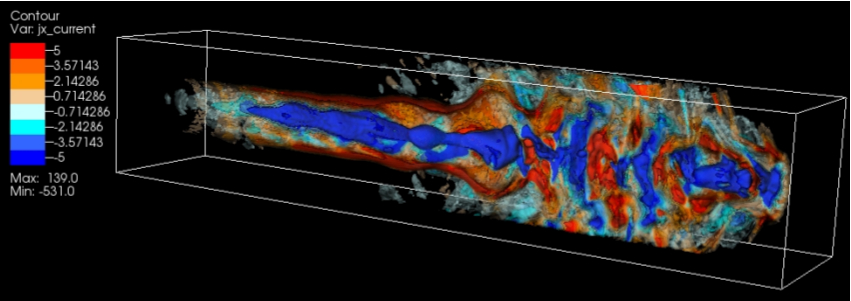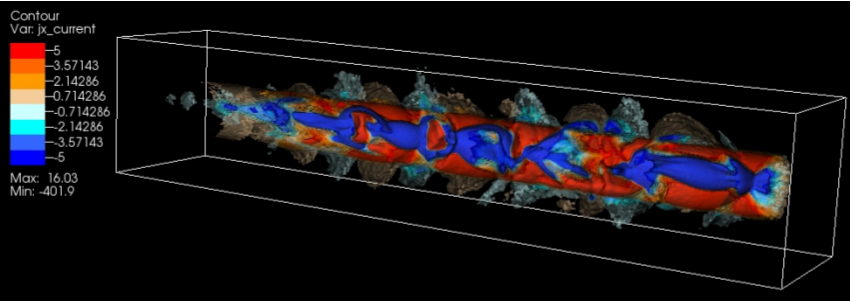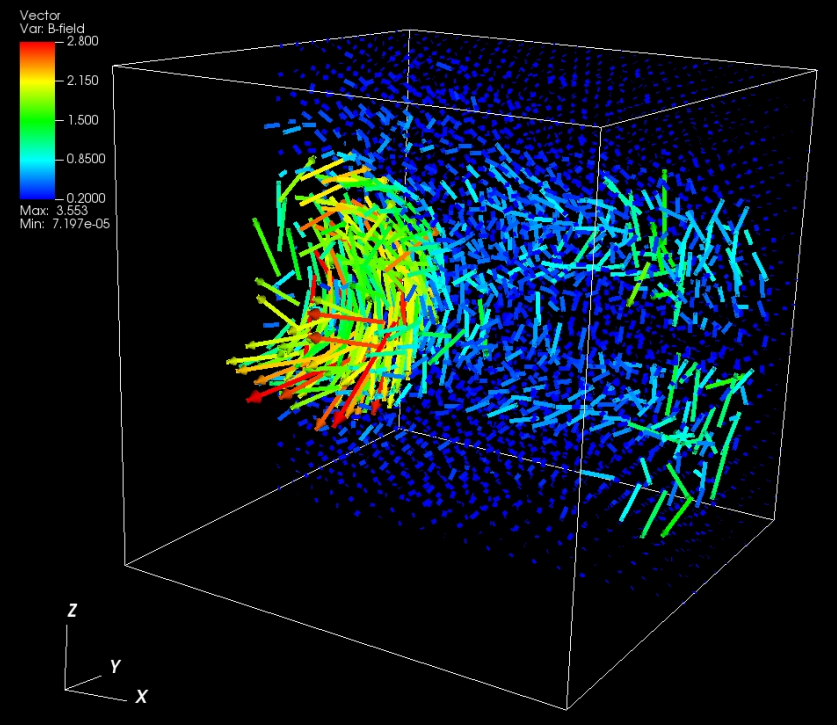Particle-in-cell simulations of plasma shocks and instabilities in relativistic jets
Particle-in-cell (PIC) simulations of collisionless shock formation and instability growth, such as the Weibel instability, the kinetic Kelvin-Helmholtz instability (kKHI), and the Mushroom instability (MI), have been performed to study magnetic field generation, particle acceleration, and emission of radiation with applications to astrophysical plasma jets, like those of active galactic nuclei (AGN) and gamma-ray bursts (GRBs).
Nishikawa et al. (2016) were the first to present results of numerical PIC simulations of global relativistic jets containing helical magnetic fields. The presence of helical magnetic fields in the jets is suggested by twisted structures that have been observed in many AGN jets, from sub- to kiloparsec scales.

 The main result obtained by Nishikawa et al. (2016) has revealed that new types of shocks, similar to recollimation shocks attained in relativistic magnetohydrodynamic (MHD) simulations, occur when a relativistic plasma jet contains a helical magnetic field. In the (e--p+) jet case (left figure), recollimation-like shocks are developed. In the (e--e+) jet case (right figure), small recollimation structures are initially formed, and after instabilities have grown, the currents expand outside the jet and the current density becomes turbulent.
The main result obtained by Nishikawa et al. (2016) has revealed that new types of shocks, similar to recollimation shocks attained in relativistic magnetohydrodynamic (MHD) simulations, occur when a relativistic plasma jet contains a helical magnetic field. In the (e--p+) jet case (left figure), recollimation-like shocks are developed. In the (e--e+) jet case (right figure), small recollimation structures are initially formed, and after instabilities have grown, the currents expand outside the jet and the current density becomes turbulent.
 These studies were extended by Nishikawa et al. (2020) to the nonlinear stage of the growth of kinetic instabilities to explore acceleration of particles via magnetic reconnection in relativistic jets that contain initial helical magnetic fields, using a larger simulation system. In the nonlinear stage, the helical magnetic fields are untangled under the action of reconnection-like processes and disappear. The disappearance of the helical fields generates magnetic field islands, which then interact with each other producing turbulent magnetic fields. In these turbulent fields, further reconnection events take place. Then, the turbulent reconnection explosively converts the magnetic field energy into kinetic energy of the plasma, so that the jet electrons are rapidly accelerated. The ambient electrons entrained in the relativistic jet are strongly accelerated as well.
These studies were extended by Nishikawa et al. (2020) to the nonlinear stage of the growth of kinetic instabilities to explore acceleration of particles via magnetic reconnection in relativistic jets that contain initial helical magnetic fields, using a larger simulation system. In the nonlinear stage, the helical magnetic fields are untangled under the action of reconnection-like processes and disappear. The disappearance of the helical fields generates magnetic field islands, which then interact with each other producing turbulent magnetic fields. In these turbulent fields, further reconnection events take place. Then, the turbulent reconnection explosively converts the magnetic field energy into kinetic energy of the plasma, so that the jet electrons are rapidly accelerated. The ambient electrons entrained in the relativistic jet are strongly accelerated as well.
ISI papers:
- Nishikawa, K.-I., Mizuno, Y., Gómez, J. L., Duţan, I., et al., Rapid Particle Acceleration due to Recollimation Shocks and Turbulent Magnetic Fields in Injected Jets with Helical Magnetic Fields, MNRAS, 2020
- Nishikawa, K.-I., Frederiksen, J. T., Nordlund, Å., Mizuno, Y., et al., Evolution of global relativistic jets: Collimations and expansion with kKHI and the Weibel instability, ApJ, 820, 94, 2016
- Nishikawa, K.-I., Hardee, P. E., Duţan, I., Niemiec, J., et al., Magnetic field generation in core-sheath jets via the kinetic Kelvin-Helmholtz instability, ApJ, 793, 60, 2014
- Nishikawa, K.-I., Zhang, B., Duţan, I., Medvedev, M., et al., Magnetic field generation in a jet-sheath plasma via the kinetic Kelvin-Helmholtz instability, Ann. Geophys., 31, 1535, 2013
- Nishikawa, K.-I., Hardee, P. E., Mizuno, Y., Duţan, I., et al., Radiation from accelerated particles in relativistic jets with shocks, shear-flow, and reconnection, EPJ Web of Conferences, 61, 02003, 2013
Non-ISI papers:
- Nishikawa, K.-I., Mizuno, Y., Gómez, J. L., Duţan, I., et al., Relativistic Jet Simulations of the Weibel Instability in the Slab Model to Cylindrical Jets with Helical Magnetic Fields, Galaxies, 7, 29, 2019
- Nishikawa, K.-I., Mizuno, Y., Gómez, J. L., Duţan, I., et al., Microscopic Processes in Global Relativistic Jets Containing Helical Magnetic Fields: Dependence on Jet Radius, Galaxies, 5, 58, 2017
- Duţan, I., Nishikawa, K.-I., Mizuno, Y., Niemiec, J., et al., Particle-in-cell simulations of global relativistic jets with helical magnetic fields, Poceedings of the International Astronomical Union (IAU) Symposium, 324, 199, 2017
- Nishikawa, K.-I., Mizuno, Y., Niemiec, J., Kobzar, O., et al., Microscopic processes in global relativistic jets containing helical magnetic fields, Proceedings of Blazars through Sharp Multi-Wavelength Eyes, Málaga, Spain, 30 May - 3 June 2016; Published in Galaxies, 4, 38, 2016
Talks:
- Synthetic spectra for the emission of radiation from accelerated electrons in relativistic jets using particle-in-cell numerical simulations, Seminar talk at the Alabama A&M University, Huntsville, USA, 19 November 2019
- Synthetic spectra for an off-axis afterglow from a short gamma-ray burst, COSPAR 2018, Pasadena, California, USA, 14-22 July 2018 [PDF]
- Particle-in-cell simulations of global relativistic jets with helical magnetic fields, IAU Symposium No. 324: New Frontiers in Black Hole Astrophysics, Ljubljana, Slovenia, 12-16 September 2016

